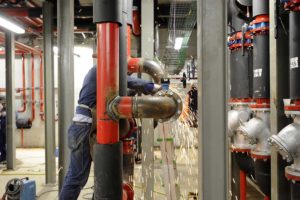Disclaimer: The information on our website is provided for general information purposes only. We make no representations or warranties of any kind, express or implied, about the completeness, accuracy, reliability, suitability or availability with respect to the website or the information contained on our website for any purpose. Any reliance on such information is therefore strictly at your own risk and we are not liable for any damages or losses arising out of or resulting from your reliance on any information contained on our website.
A welder fabricates and puts together metal parts and use of various machines that create intense heat. Additionally, they smooth and polish the metal surfaces once welded together. Welders must have the ability to study blueprints or project specifications and calculate the dimensions of the welded parts. These professionals also inspect materials or structures that need welding, monitor their work, and maintain the machinery and equipment they work with.
Watch a video:
How to Become a Welder

Most welders have a high school diploma or equivalent and then earn a professional certification. Certifications can be gained at vocational schools, community colleges, or private programs. On-the-job training is often included in these training programs. Courses in these training programs teach you how to read blueprints, use shop mathematics, mechanical draw, basic physics, chemistry, and metallurgy classes.
A welder can also gain certification through the American Welding Society (AWS). According to AWS, this certification opens up opportunities for more money, leadership roles, and higher-level career challenges. AWS offers nine different certification categories from inspectors, supervisors, and educators to radiographic interpreters, welding engineers, and fabricators.
Job Description of a Welder
A welder’s primary duty is to join metal parts together. They may also fix holes in metal objects as well. They work on the metal components of various structures to include pipelines, bridges, power plants, buildings, refineries, automobiles, or ships. There is also more to welding than most people may realize. For instance, there are more than 100 different welding processes a welder can use, but the most common is arc welding.
Welders work full-time and may often work overtime. Though they may work indoors, there are also welders that work primarily outdoors and are exposed to hazardous situations on a daily basis. Because of this, they may work in confined spaces, on scaffolding, or in inclement weather. Welders with the highest skill levels and a willingness to relocate have the greatest advantage for solid employment. Welders can also take their skills and compliment them with another trade, such as commercial diving.
Welder Career Video Transcript
Welders, cutters, solderers, and brazers use hand-held or remotely controlled equipment to join or cut metal parts, or to smooth surfaces. These workers study sketches and specifications to understand the full picture of the structure and materials before they start their work. Welders and cutters’ tools use high heat to soften the material.
Welders use these tools to join metal in a wide variety of industries, from car racing and manufacturing to steel beam construction. Cutters cut and trim metal objects, or dismantle large objects such as ships and railroad cars. Work may be outdoors on a scaffold or high platform, or indoors in confined areas. Bending, stooping, and heavy lifting are common. Soldering and brazing workers use molten metal to join two pieces of metal. Soldering involves precision tasks such as forming joins in electronic circuit boards, while brazing uses metals at higher temperatures to, for example, apply coatings to parts for protection against wear and corrosion. Other workers in this field manage machines or robots that perform welding, brazing, soldering, or heat treating tasks. These workers may also operate laser cutters or laser-beam machines.
Hazards include very hot materials and the intense light created by the arc. While employers are required to provide safely ventilated areas, these workers typically wear safety equipment to prevent injuries. Most positions are full-time; evenings, weekends, and overtime hours are common. High school education, along with technical and on-the-job training, is typically required to enter these fields. A certification or other skill credential is attractive to employers.
Article Citations
Bureau of Labor Statistics, U.S. Department of Labor, Occupational Outlook Handbook, Welders, Cutters, Solderers, and Brazers.
National Center for O*NET Development. 51-4121.06. O*NET OnLine.
The career video is in the public domain from the U. S. Department of Labor, Employment and Training Administration.

